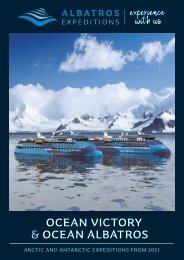Voyage 5 Log
You also want an ePaper? Increase the reach of your titles
YUMPU automatically turns print PDFs into web optimized ePapers that Google loves.
Ice is Nice – Glacier Fun Facts<br />
Gaby Pilson, Hiking Master & Expedition Guide<br />
Glaciers have, quite literally, shaped our world. Without glaciers, the rolling hills and wide valleys we know<br />
today would look very different, but it turns out that these icy giants have a much longer and more storied<br />
history than many of us would initially suspect. Here are some of the best fun facts about glaciers:<br />
2<br />
4<br />
© Renato Granieri Photography<br />
Glaciers are formed by snowflakes. Although it’s<br />
crazy to think that a tiny snowflake can create<br />
something as large as a glacier, without snow,<br />
glaciers would never exist in the first place. To<br />
form a glacier, massive amounts of snow must<br />
accumulate and persist in a single location all<br />
year-long for hundreds, if not thousands of<br />
years. During this time, the individual snowflakes<br />
found in the snowpack change in a process<br />
known as snowflake metamorphosis, where<br />
individual ice grains fuse together and get bigger<br />
and air bubbles get smaller. Once the icepack<br />
builds up enough mass to start flowing downhill,<br />
then voila! We have a glacier.<br />
© Renato Granieri Photography<br />
1<br />
3<br />
Page 12<br />
Not just anything can be a glacier. In fact, there’s<br />
a size requirement that a piece of ice has to<br />
meet to become a glacier. Anything considered a<br />
glacier must be at least 0.1 km 2 (nearly 25 acres)<br />
in area to be worthy of the name. Although<br />
there’s a minimum size requirement to be<br />
considered a glacier, there’s no upper limit to<br />
glacierhood. The longest glacier on earth is the<br />
Lambert Glacier of Antarctica, which measures<br />
out to some 434 km (270 mi) long. The world’s<br />
largest non-polar glacier is the Fedchenko<br />
Glacier of Tajikistan, which measures a<br />
respectable 77km (48mi) long.<br />
© Renato Granieri Photography<br />
Glaciers are found all over the world, not just in<br />
the polar regions. While the majority of glaciers<br />
and glacial ice is concentrated in high northern<br />
and southern latitudes, glaciers are found even<br />
near the equator, such as on Mount Kilimanjaro<br />
in Tanzania and in the mountains of Ecuador.<br />
That being said, about half of the world’s<br />
200,000 glaciers are found in one place: Alaska.<br />
There, glaciers cover a whopping 72,500 km 2<br />
(28,000 mi 2 ) of the US state’s total area. That’s a<br />
lot of ice.<br />
Glaciers are basically really, really, really slow-moving rivers. To be considered a glacier, a large mass of ice<br />
must be physically moving downhill. This movement downhill is driven by gravity and is the main reason<br />
why glaciers also act as major agents of erosion. Since glaciers move downhill, they often remove and<br />
transport large boulders and chunks of rock, depositing them much further downhill then where they<br />
started.<br />
23-30 June, 2019<br />
Volume 1, Issue 5


















